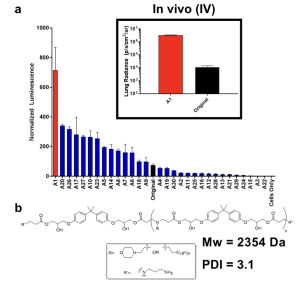42 Scientific Paper on Optimization of a Degradable Polymer
Andrianna Hodges; mmdingle; and tmward2
The scientific article that we chose is the ‘Optimization of a Degradable Polymer−Lipid Nanoparticle for Potent Systemic Delivery of mRNA to the Lung Endothelium and Immune Cells,’ in which Kaitlyn Sadtler is the co-author of.
This article analyzes the advancements in developing effective methods for delivering in vitro transcribed (IVT) mRNA for therapeutic purposes. IVT mRNA is used for therapeutic use due to its transient expression and decreased risk of genomic integration compared to DNA-based therapies. Some of the challenges associated with therapeutic mRNA delivery include degradation by RNases, cellular uptake, and escape from endosomes. In this article there was also a focus on non-viral nanoparticles, which have emerged as promising delivery vehicles for mRNA due to their versatility and potential for specific tissue targeting. PBAE nanoparticles are optimized for mRNA delivery, focusing on synthesis specifications such as monomer composition, molecular weight, and enc-capping. For the experiment, the researchers utilized a design of experiment approach to methodically explore multiple synthesis and formulation specifications to enhance nanoparticle efficacy and specificity for lung targeting. Nanoparticle synthesis involves a stepwise process of polymerization followed by nanoparticle formulation using mRNA and PEG-lipid components, which were then tested for efficacy in vitro and in vivo. The optimized nanoparticle formulation (A1-L3) displayed significantly improved mRNA delivery to the lungs, with high specificity for lung endothelial and immune cells, as exemplified by florence-based cell tracking studies. Through iterative screening processes, the researchers identified main parameters that influence performance, which includes end-cap type, PEG-lipid composition, and nanoparticle size. This study also identifies the potential therapeutic applications of the optimized nanoparticles, such as in immunotherapy and gene editing. This is due to their ability to efficiently deliver mRNA to specific target cells within the lungs. Future research studies involve investigating optimizing nanoparticles for other organs and therapeutic contexts, leveraging experimental design methodologies to refine RNA delivery vehicles. In conclusion, this research highlights the importance of systematic optimization in nanoparticle design for mRNA delivery, displaying the potential for developing effective and targeted RNA therapeutics using nonviral delivery systems.

Media Attributions
- Screen Shot 2024-04-23 at 12.25.45 PM

